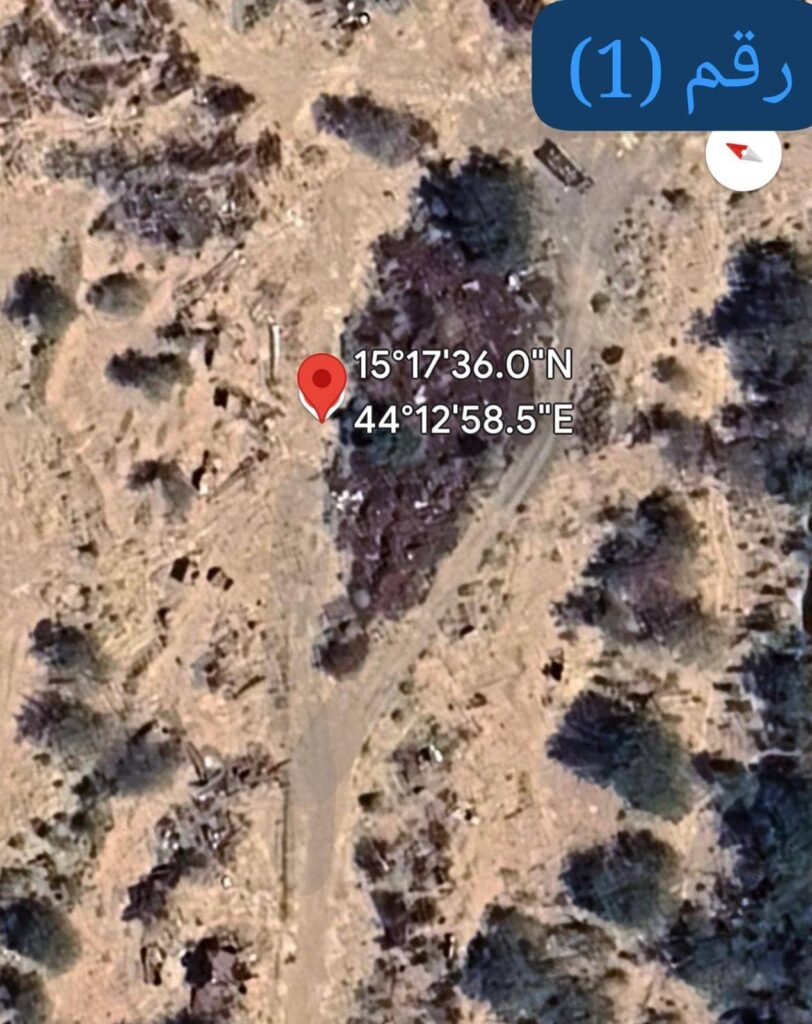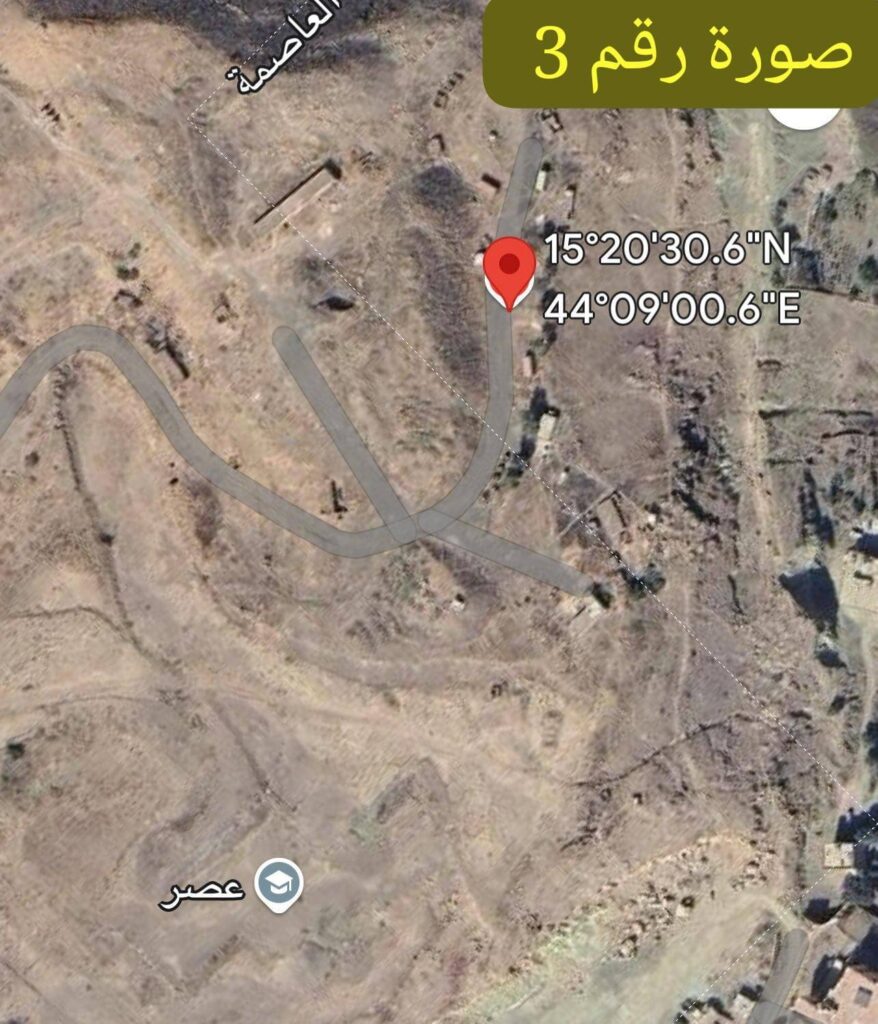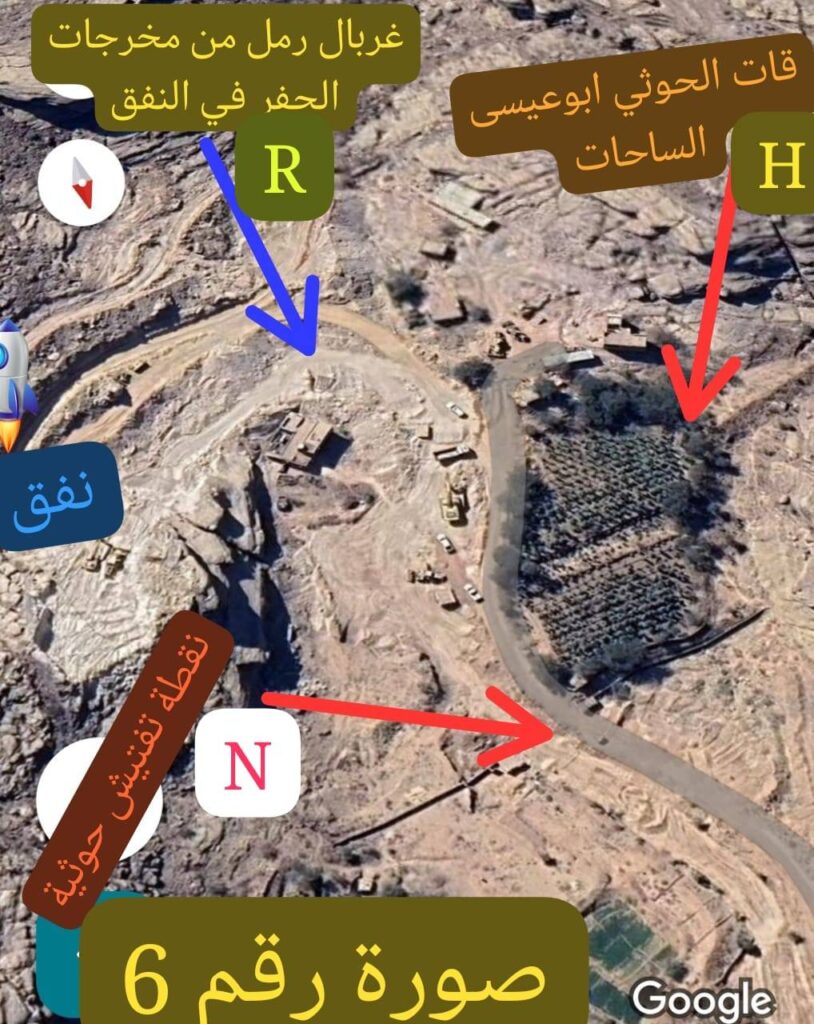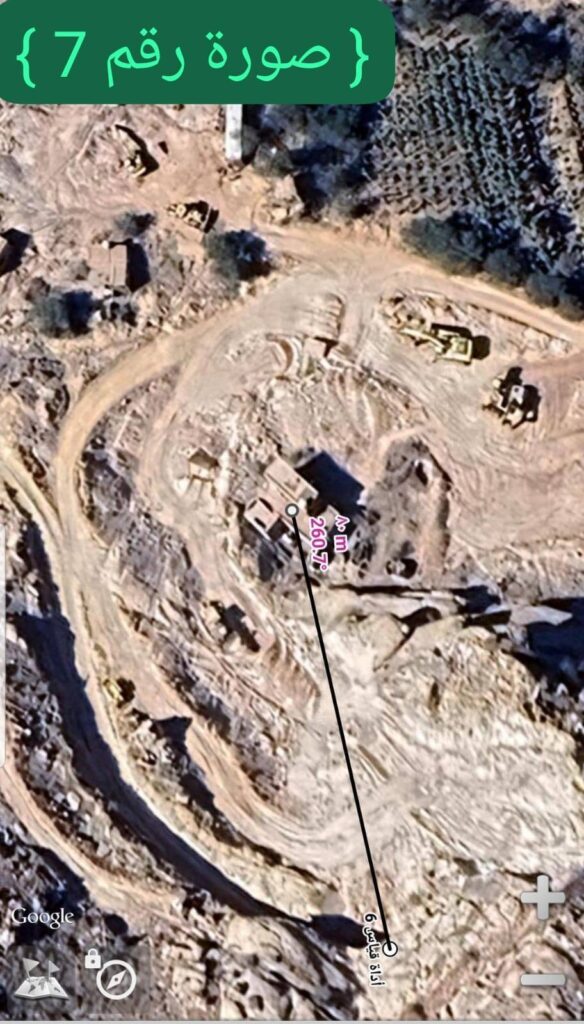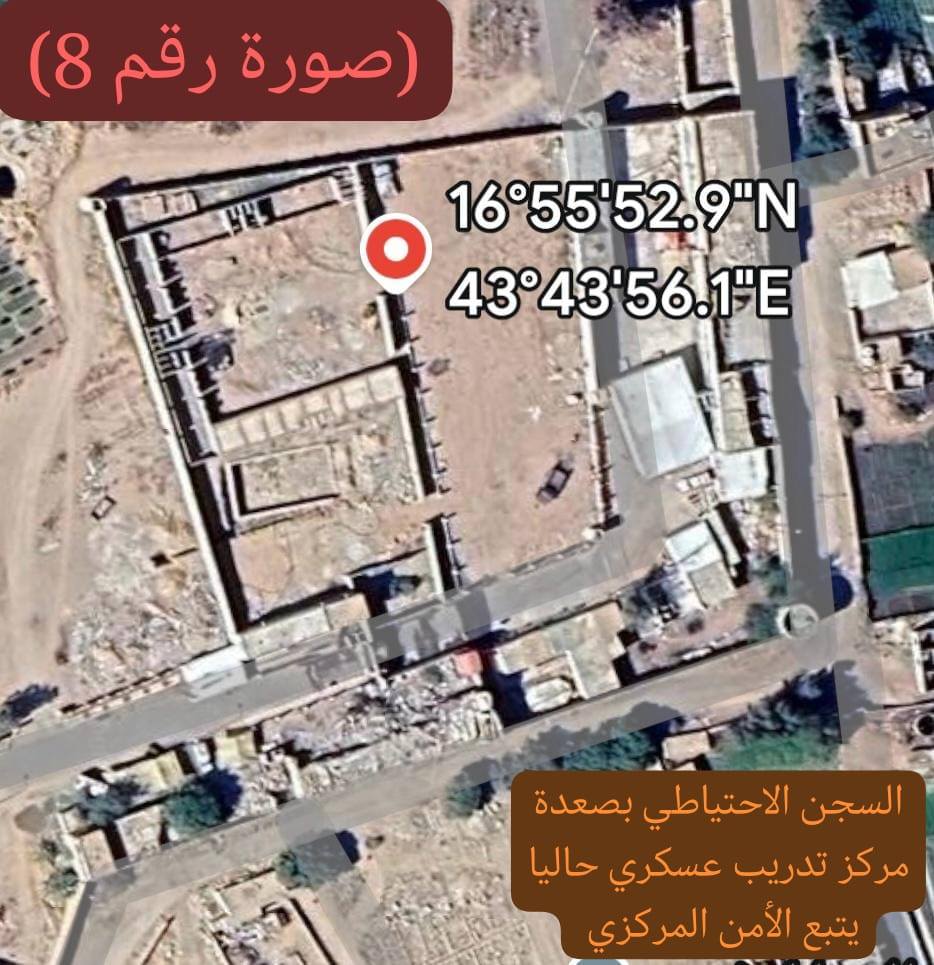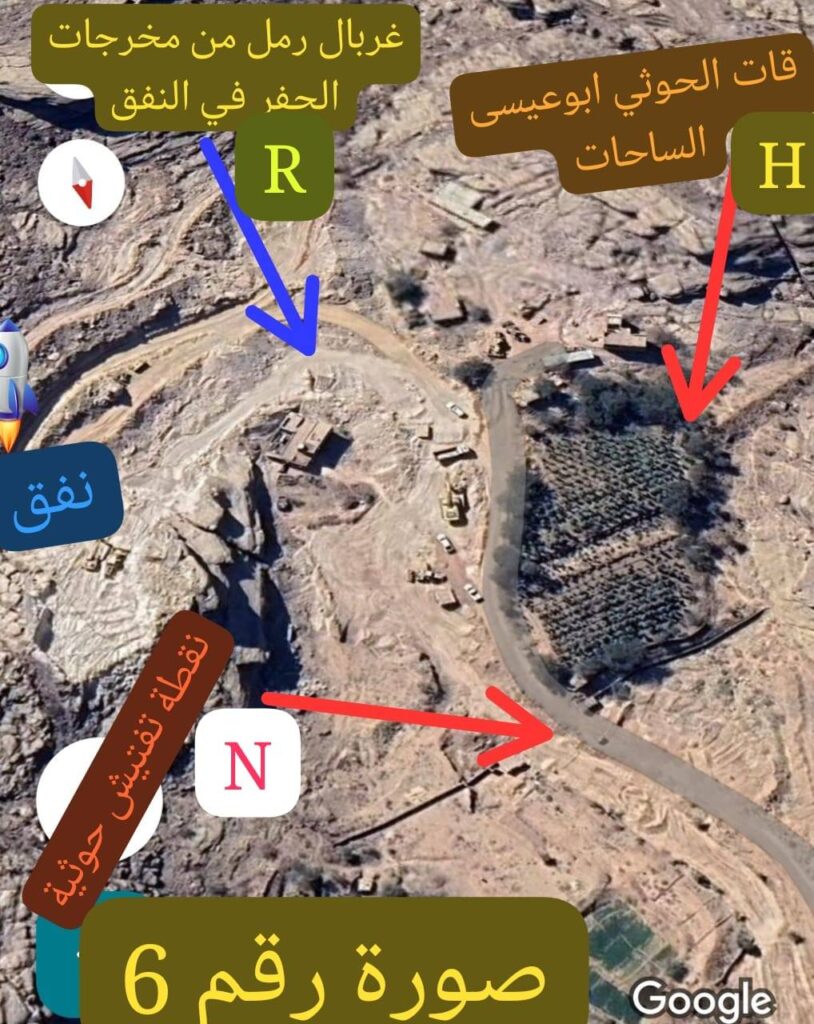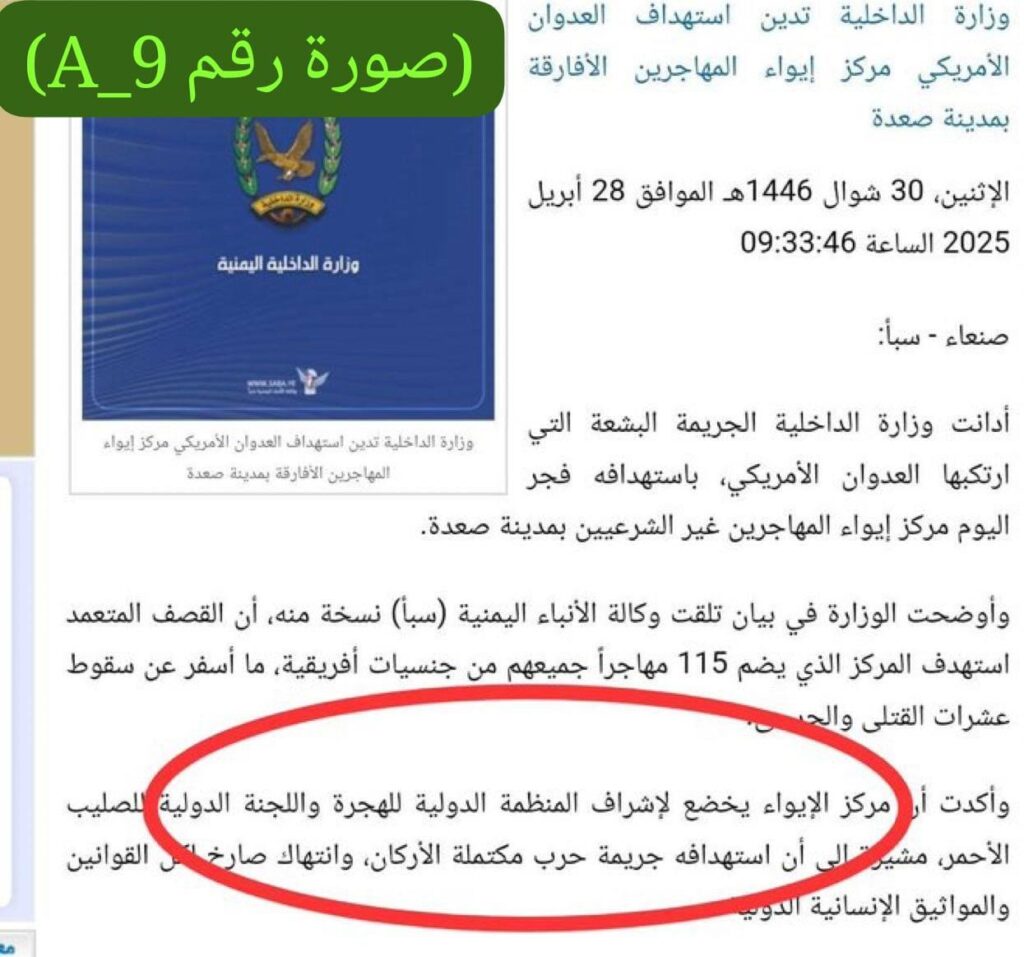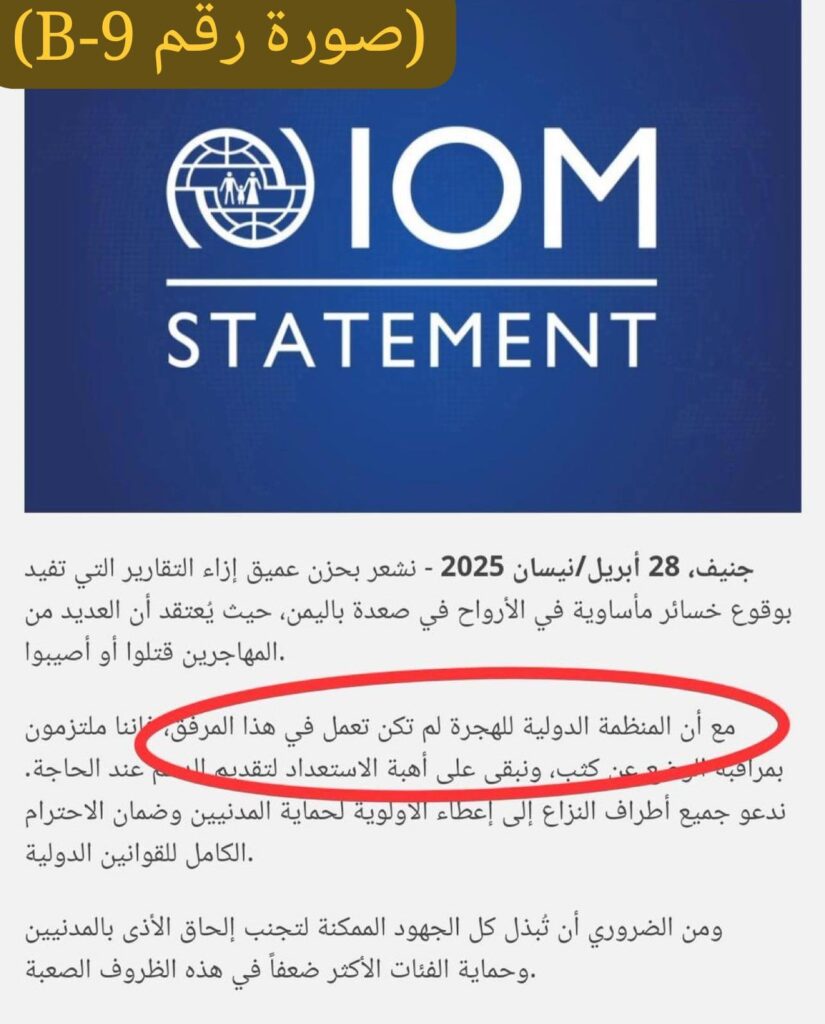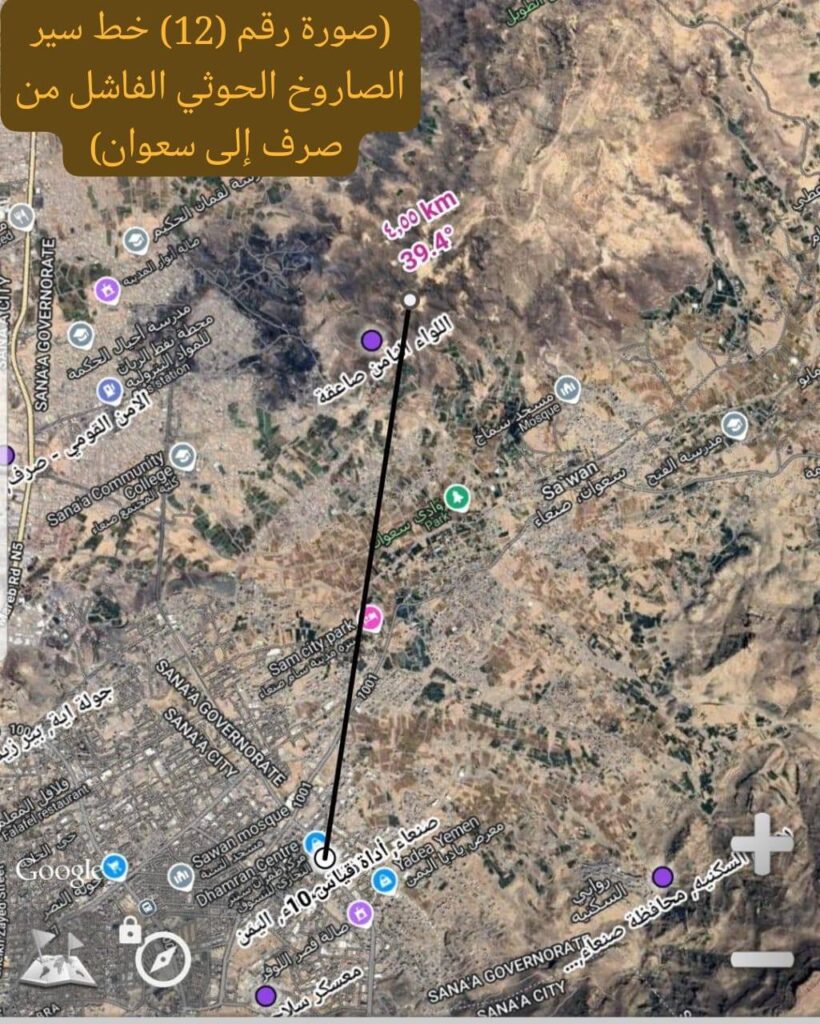Targeting Civilians with Missiles… Who Is Responsible?!!
Targeting Civilians with Missiles… Who Is Responsible?!!
A report provides evidence of crimes and violations committed against civilians by Houthi militia’s missile strikes, followed by a statement of Eradah Organization to Combat Torture and Forced Disappearance.
-1-
On Saturday evening, April 19, 2025, Houthi militia members launched
rocket from the southern part of An-Nahdayn military camp, located south of the Presidential Palace in Sana’a (pict.1 shows the launch site location). The rocket was aimed at a U.S. MQ-9 reconnaissance drone but failed to hit its target. Instead, it landed in Majel Ad-Demmah Cemetery, near Bab Al-Yemen, between the beginning of Taiz Street and Amr Ibn Ma’adi Yakrib Street in Sana’a, creating a small hole in the cemetery (pict. 2)
.The size of the hole clearly indicates that it was not caused by a missile fired from a U.S. fighter jet, as those typically cause extensive damage and large holes, especially when striking soft, sandy ground like that found in cemeteries.
The missile’s fall resulted in damage to several civilian homes adjacent to the cemetery. According to available information, the missile was a Soviet-made “Kvadrat” type, modified by Iranian engineers in Sana’a. However, according to a military source, its accuracy against U.S. warplanes is virtually zero, and its probability of hitting reconnaissance drones does not exceed 10%.
Houthis’ decision to launch such a missile, knowing it would fly over densely populated civilian areas, recklessly endangered civilian lives. Once the missile reaches the end of its range, it simply falls, often onto civilian neighborhoods.
Instead of admitting their mistake, apologizing to the civilians, and compensating them for the damages, Houthis denied their involvement in launching the missile and even exploited the incident for propaganda purposes.
– 2 –
On Sunday evening, April 20, 2025, Houthis launched another missile from the same site of the previous one, (shown in pict. 1). The ones directly responsible for launching the missile were Major Hashim Al-Kibsi, along with Ismail Al-Kibsi and a third member from Al-Ghaithi family. The missile aimed at targeting a U.S. MQ-9 reconnaissance drone but failed to hit it, falling instead into a residential area in Farwah neighborhood of Shu’ub District in the capital, Sana’a. Because the missile fell in the middle of a crowded local market, 12 civilians were killed and 31 others injured, in addition to damaging commercial shops and shattering windows in nearby homes.
The following Youtube link shows the impact of Houthi’s missile fell into Farwah Market:
https://youtu.be/EkktTc99np0?si=GRoObrHUxIEhrOsj
Here, also, is another video filmed by local residents, showing Houthi missile in the sky, flying horizontally from Jabal An-Nahdayn, just before it fell on Farwah Market:
https://youtube.com/shorts/77q0cFmH21I?si=mAJLvQuyYyu2aWPe
In both incidents, Houthis deliberately misled the public, falsely claiming that the missiles were launched by American aircraft. In Farwah Market incident, there was no deep hole at the missile fell site, that could be further evidence contradicting their claims.
– 3 –
On Monday evening, April 21, 2025, Houthis launched another missile from a military site in Asr area western Sana’a, (the location is shown in pict. 3). The missile fell on Jabal Al-Za’laa in Ibn Abdullah subdistrict of Al-Mahwit Governorate. Local youth from the area captured footage of the event.
You can watch the video at the following link:
https://youtu.be/Ps6KfgWGcvk?feature=shared
The video’s circulation on social media embarrassed Houthis, as they deliberately seek to conceal their violations against civilians. In response, they imposed the use of the word “madri” (“I don’t know”) and banned people from filming, which is an act of constituting a restriction on freedom of expression and the right to report the truth.
The young man who filmed the video mocked Houthis, spontaneously commenting: “Numbered with a marker, no shame at all,” referring to the fact that the missile’s serial number was written manually with a broad-tipped pen.
This remark sparked widespread ridicule across social media platforms and triggered a furious crackdown by Houthi militia.
As a result, those young men, most of them minors, were abducted and remain forcibly disappeared. Their names are:Abdulaziz Mohammed Sagheer Nayef Al-AshmouriMohammed Yahya Ahmed Al-AbadiNassar Nasser Ali Al-AshmouriMithaq Abdullah Al-HaraziIssam Abdu Abdullah MadhnounAdeeb Mohammed Mohammed Al-Sayrani Reports indicate that they have been subjected to torture by members of Houthi security and intelligence apparatus, in blatant violation of human rights and protections for children.
– 4 –
Houthis have concealed dozens of ballistic missiles in a tunnel located in Thuqban area of Bani Al-Harith District, Sana’a Governorate, (shown in pict. 4_A). The picture reveals the tunnel entrance, and on the other side is the missile launch site, but so far unused.
Houthis stored missiles in one section of the tunnel as a depot, while manufacturing them in a smaller, branching tunnel within the main structure. From time to time, Houthis transfer one or two missiles from this location to various other sites, from which they later launch them at selected targets.
Houthis used part of this missile stockpile in their war against legitimate government and the Arab Coalition forces before the UN sponsored truce, including launching missiles at Kingdom of Saudi Arabia during past years of conflict. In the final months of 2024 and into 2025, they moved missiles multiple times from this tunnel. The most recent case involved two missiles launched from a waste dump in Al Azraqain area near Jadr neighborhood, putting the lifes of civilians in that area at severe risk.
As truth researchers and monitors documenting violations against civilians, we emphasize using civilians as human shields in dangerous military zones, and launching missiles over residential neighborhoods have caused dozens of deaths and injuries throughout 2025. Houthis’ use of human shields has been a recurring tactic over the past ten years since their coup against Yemen’s government.
After verifying Houthi military activity in this area, surrounded by civilian homes, we consulted a trusted military source in Sana’a who requested anonymity. We asked him the following:
1.
Has the site been used by Houthis for military purposes?He confirmed that there is a strategic missile tunnel at the site which has been in use by Houthis for seven years.
2.
How can such a site be used for military purposes when it is located next to homes with women and children?He stated that Houthis don’t care about civilians; their focus is solely on military objectives. He added that Houthis’ claims are outright lies and deception aimed at misleading the Yemeni people.
U.S. Airstrikes on Thuqban Area (Details):
On the evening of April 27, 2025, U.S. aircraft conducted six airstrikes on Thuqban area (pict. 4_A), targeting the entrance of the strategic tunnel (number 6 in pict. 4_B), killing a missile manufacturing engineer and four of his assistants who were working in the tunnel and happened to be near its entrance when the roof collapsed on them. Four of them were from Saada Governorate, the fifth from Al-Jawf. A sixth member was also killed while inside the house of Mukhtar Al-Barti.
The airstrikes also hit all buildings surrounding the tunnel, destroying house number (3), which belonged to Ali Yahya Salah Masoud, who was killed along with his wife Ameera and their children Yahya, Saleh, Bushra, Yusra, Dhekra, and Fatima, may they all rest in peace.Photos of the victims are attached below the report (pict. 5).
The airstrikes also hit the home of Houthi leader Nashwan Al-Jamlouli (house number 4 in pict. 4_B). He had left the location after receiving information that the area would be targeted by U.S. airstrikes. His mother had left a day earlier but returned the following day with Nashwan’s wife and their children, dismissing her son’s warning that Houthis had informed him about the imminent attack. Encouraged by the fact that their neighbors, the family of Ali Yahya, had remained in their homes and hadn’t evacuated, she refused to leave again the next day, telling her son: “Don’t believe the Houthis from Saada, they want us gone so they can seize our property.” The strike hit, and she and the child Omar Nashwan were killed, may they rest in peace.
House number (5) in pict. 4_B, belonging to the family of Hussein Obaid, was also bombed. Their son, Saddam Hussein Abdullah Obaid, was killed in the attack, and two other children were injured with fractures. The rest of the family survived.
The strike also targeted, in the same place, the house number (2) in pict. 4_B, which was being used as a resting place for the tunnel guards.Additionally, house number (1) in pict. 4_B, belonging to Mukhtar Al-Barti, was hit, although the family had already evacuated before the bombing.
What Houthis Are Hiding About the Incident:
This story began years ago, after the fall of Sana’a and the killing of former President Ali Abdullah Saleh in 2017. Houthi leaders from Saada arrived in Wadi Thuqban. These individuals include:
Abu Issa Al-Sahat, whose real name is Ali Mohsen Hassan Hussein Dahmash Al-ubadi, from Ash-Sha’af, Saqayn District, Saada Governorate, a highly dangerous Houthi leader. He previously served as Houthi supervisor for Nihm District east of Sana’a, then for Bani Al-Harith District, and he is currently the commander of the 10th region in Saada.
The other two terrorists are:
Hamad bin Rakan Al-Sharif, a dangerous Houthi from Majzar in Marib Governorate.
Abu Yahya Al-Hadi, another senior Houthi operative.
In 2018, these three leaders offered citizen Ali Yahya Salah Masoud 40 million Yemeni riyals for his house and all his family’s agricultural land, a price far below the actual value of his property. He refused the offer and chose to remain in his home and farm.
At the same time, they rented the mountain from Mukhtar Al-Barti under the pretense of establishing a sand crusher business, paying eight million riyals annually. A 10-year contract was signed. The mountain was leased from the valley side, as shown in (pict. 4_A).Later, Abu Issa Al-Sahat married the daughter of Ali Yahya’s cousin and encouraged both Mukhtar Al-Barti and Ali Yahya to increase qat cultivation in the valley. However, available information suggests that Ali Yahya was not ideologically aligned with Houthis; rather, he was going along with the situation out of fear for his property. His father and brothers also appeared to support Houthis outwardly, mainly out of fear that their wealth would be seized by Houthis.
Houthi Methods to Conceal the Tunnel:
The location was chosen near qat trees to camouflage the tunnel (pict. 6_H).
The excavation debris from the tunnel is recycled by Houthi members and sold as sand (“naysah”). It is loaded onto dump trucks owned by Houthi militia members and sold on the market (pict. 6_R).
Over the past period, Houthi elements built a wall along the road extending to the main asphalt road and established an armed checkpoint to prevent anyone other than the residents of the four houses from entering, while also inspecting them, as shown in (pict. 6_N).
After the airstrike, Houthis removed the checkpoint and allowed people to enter and see the homes of the victims of the bombing, feigning sympathy for them in front of the public. Later, the checkpoint was replaced, the rubble was cleared, the tunnel entrance was reopened, and the dead were retrieved.
Al-Masirah, Houthi TV channel, deliberately filmed from only one angle, avoiding directing the camera toward the tunnel. No clear photos were taken showing the full structure of the houses; instead, they showed only the damaged parts of the buildings to obscure the scale of the homes and the surroundings of the tunnel (from houses 1 to 5 as shown in pict. 4_B).
Funeral Processions: Houthis held funerals for 16 people, including 8 from the family of Ali Yahya, himself, his wife, and their children, as well as Nashwan Al-Jamlouli’s mother and son Omar. Saddam Hussein Obaid was not given a funeral. The remaining 6 were Houthi militia members who had been working inside the tunnel.
Types of Violations Committed:
Houthis’ selection of a civilian, residential, and agricultural area for establishing a missile production facility and bringing in heavy machinery for tunnel excavation near homes where children lived, disturbing them day and night.
Houthis used civilians around the tunnel, where ballistic missiles were being Produced, as human shields.Houthis’ disregard for civilian lives and for the fundamental right to life, which is enshrined in all international laws and treaties.
The gathering of materials used in missile manufacturing, extremely dangerous and potentially catastrophic if detonated, inside a tunnel located just 80 to 300 meters from civilians’ homes. The closest home is only 80 meters from the tunnel entrance (pict. 7).Transporting missiles through residential neighborhoods from the tunnel to the launch site in Al Azraqeen garbage dump exposes civilians to serious danger, whether due to targeted airstrikes, explosions, or other causes. Indeed, 11 civilians in Thuqban area were killed by U.S. airstrikes, including 7 children and 2 women, in addition to 6 Houthi militia members.
– 5 –
Saada Detention Center Airstrike Crime… Who Is Responsible?
The Beginning:
Houthis received information from a double agent (who provided coordinates to external parties in exchange for money. At the same time, he warned Houthis about potential airstrikes, earning payments from both sides). This agent told Houthis that the U.S. would target Saada detention center due to Houthis having recruited three battalions from graduates of Houthi summer centers, most of whom were African Muslims who had undergone brainwashing courses by Houthis.
Upon receiving this information, Houthis evacuated the three battalions from the prison yard, where they had been undergoing intensive military training, some of them Africans (pict. 8).
On Sunday afternoon, April 27, 2025, Houthis evacuated 49 Yemeni detainees from the basement of the building, most of whom were from Saada, and forcibly disappeared them. Meanwhile, they deliberately left the Africans in the hangar to exploit their deaths. We confirm the accuracy of this information.
The U.S. air force struck the detention center with two airstrikes on April 28, 2025, one of which hit the hangar housing African migrants who had refused to be recruited or pay money. The bombing killed 68 migrants and injured 65 others.
While both Houthis and the U.S. air force share responsibility for the massacre, Houthis bear the greater responsibility for the following reasons:
Using the prison yard to train three combat battalions, including African fighters, in a highly dangerous security situation during wartime.
Using African migrants who refused to be recruited or extorted as human shields to conceal Houthi military training activities.
Houthi racism in evacuating all Yemeni detainees along with combat battalions, while leaving African migrants behind, and making those who refused recruitment vulnerable to bombing, even though Houthis had received information about the imminent strike 24 hours in advance.
Arbitrary and unjustified detention of African migrants by Houthis, torturing and depriving them of their basic rights forcing them into recruitment or paying dollars in exchange for passage. Those who had no money and refused to join the militia were left as scapegoats.
Houthis’ criminal history of deliberately killing hundreds of African migrants in recent years, most notably:
The massacre of African migrants in Al-Ghar, Raqu, Monabbih District, Saada Governorate, where Houthis burned 300 migrant camps on the morning of Thursday, April 16, 2020, killing 132 migrants with gunfire and artillery.The horrific massacre at the immigration hangar on Khawlan Street in Sana’a, where Houthi militia members set the detention center on fire on March 7, 2021, killing 64 Ethiopian migrants and injuring 203 others.
Houthis falsely claimed that the site bombed by U.S. aircraft was a shelter supervised by the International Organization for Migration (pict. 9_A). However, IOM denied this claim, stating they had no involvement with that center (pict. 9_B).
We, Eradah Organization to Combat Torture and Forced Disappearance, hold Houthi militia primarily responsible for these violations and for their disregard for civilian lives, looting of property, and use of human shields in combat operations. We do not absolve the U.S. air force of responsibility for certain incidents and call for an impartial international investigation to verify these grave violations.
– 6 –
On May 5, 2025, Houthis launched a missile from the Sarf area east of Sana’a. (Location is shown in pict. 10). The missile targeted a U.S. MQ-9 reconnaissance drone but failed to hit it. It instead fell in Al-Arba’een Street, next to Dhamran Center Mall, in Shaoub District of the Yemeni capital, Sana’a. The impact left a small hole on the pedestrian sidewalk (pict. 11). The missile’s fall in a residential area near a commercial center resulted in 14 civilian injuries, damaged several shops, and shattered windows in nearby homes. (Missile trajectory shown in pict. 12).
Conclusion):
Eradah Organization to Combat Torture and Forced Disappearance strongly condemns the continued crimes committed against civilians in Yemen and the use of civilians by Houthis as human shields in the ongoing conflict between the United States and Houthi militia.
While we, Eradah Org, don’t absolve U.S. airstrikes of potential mistakes, particularly if civilians are deliberately targeted, we place the greater share of responsibility on Houthi coup authorities in Sana’a, who have shown blatant disregard for civilian lives. Their media apparatus has intentionally misled both local and international public opinion about the reality on the ground in Yemen.
Houthis have deliberately endangered and killed civilians in Sana’a and across other Yemeni governorates by launching missiles at enemy aircraft, fully aware that those missiles would fall back onto residential neighborhoods and cause civilian casualties. They have exploited Yemeni blood for media and human rights propaganda that distorts the truth, using these incidents to provoke international sympathy and portray themselves as victims while mourning civilians they themselves intentionally killed.
We, Eradah Organization, hold Houthi militia fully responsible for the consequences of failed missile launches, dozens of which have fallen in Sana’a alone. For two months, Houthis recklessly fired air-defense missiles that frequently landed in civilian areas, causing chaos and casualties.
We also hold Houthis accountable for the forced recruitment and extortion of African migrants, using them as human shields in their terrorist operations. Based on hundreds of verified reports, Houthis have blown up several prisons and detention centers throughout the war, using detainees as human shields in multiple governorates, and have falsely attributed their ethnic cleansing crimes to airstrikes in clear violation of human rights. The information spread by Houthi-affiliated organizations, which operate without neutrality or professionalism, is nothing but lies fabricated by agents linked to Houthi intelligence services.
We, Eradah Organization, call for the formation of an international fact-finding committee to investigate alleged crimes against civilians. We express our full readiness to cooperate with any neutral international body and to provide all available evidence and documentation. We emphasize that Houthis’ practices against civilians, including unlawful abductions, enforced disappearances of thousands of detainees, torture, and brutal suppression, are crimes that don’t subject to limitation.
We condemn and denounce Houthis’ desperate attempts to suppress voices, hide the truth, and mislead public opinion. We also condemn the killing of civilians by any party to the conflict.
Furthermore, we condemn Houthis’ use of residential neighborhoods to launch missiles and their leaders’ meetings in such areas, which have endangered civilians’ lives hundreds of times.
We urge the United Nations and international organizations to take responsibility toward Yemen and to put pressure on Houthi militia to unconditionally release all abductees.
Issued by Eradah Organization to Combat Torture and Forced Disappearance
11-5-2025 Republic of Yemen

